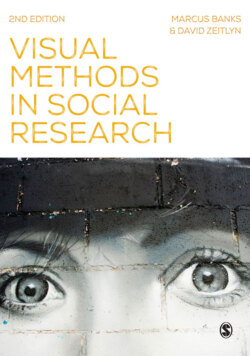Visual Methods in Social Research

Реклама. ООО «ЛитРес», ИНН: 7719571260.
Оглавление
Marcus Banks. Visual Methods in Social Research
Visual Methods in Social Research
Contents
About The Authors
Preface to the Second Edition
Acknowledgements
Image Credits
1 Reading Pictures
1.1 The trouble with pictures
1.2 An introductory example
1.3 Unnatural vision
1.4 Reading narratives
1.4.1 Formal readings5
1.5 Planning a research project with visual methods
Notes
2 Encountering The Visual
2.1 On television
2.2 Visual forms produced I: representations of society
2.2.1 Interpreting Forest of Bliss
2.2.2 Still and moving images
2.3 Visual forms produced II: representations of knowledge
2.3.1 Visualization
2.3.2 Networks8
2.3.3 Diagrams of Nuer lineages
2.4 Visual forms encountered
2.4.1 Encountering ‘indigenous’ media
2.4.2 The image as evidence
2.5 ‘Us’ and ‘them’?
Notes
3 Material Vision
3.1 Object and representation
3.2 The materiality of visual forms
3.2.1 Displaying family photographs
3.3 Exchanged goods
3.3.1 Market exchange
3.4 Size matters
3.5 Transformations: digitization and computer-based media
3.5.1 Digital manipulation
3.5.2 Digital pornography: constraining the virtual
3.5.3 Digital pornography: exchange and circulation
Notes
4 Research Strategies
4.1 Silk thread to plastic bags
4.2 Researching image use and production in social contexts
4.3 Watching television
4.3.1 Soap opera in India and Egypt
4.3.2 Television as a social presence
4.4 Doing things with photographs and films
4.4.1 Photo-elicitation with archival images
4.4.2 Photo-elicitation with contemporary images
4.4.3 Learning from photo-elicitation
4.4.4 Film-elicitation
4.5 Working with archival material
4.5.1 Photographic archives and picture libraries
4.5.2 Film archives
Notes
5 Making Images
5.1 Observing
5.2 Creating images for research
5.3 Documentation
5.3.1 A ladder climbed then discarded
5.3.2 Documentary exploration
5.3.3 Documentary control
5.4 Collaborative Projects
5.5 Indigenous media collaborations
5.5.1 Collaborative after-effects
5.6 Ethics and Visual Research
5.6.1 Ethical Review
5.6.2 Permissions
5.7 Returning Images
Notes
6 Presenting Research Results
6.1 Audiences
6.2 Presenting photographs
6.2.1 The photographic essay
6.3 Presenting ethnographic and other films
6.3.1 Study guides and other contextualization
6.4 Databases and digital images
6.4.1 Can computers see?
6.5 Multimedia projects
6.5.1 Interacting with the Yanomamö
6.6 Copyright
Notes
7 Perspectives On Visual Research
7.1 The state of visual research
7.2 The place of visual research
7.3 The nature of visual research
Notes
Bibliography
Filmography
Index
Отрывок из книги
2nd Edition
While intended as a simple and practical guide for students, academic and non-academic researchers new to the fields of visual anthropology and visual sociology, this is not a technical guide or a style manual for image production. For that, readers should consult the technical manuals readily available in any large bookshop, in conjunction with a more specialist text written by and for social scientists. For film and video, Ilisa Barbash and Lucien Taylor’s Cross-Cultural Filmmaking (1997) is both encyclopaedic in its detail and authoritative in its commentary. For still photography, Terence Wright’s The Photography Handbook (1999) is a relatively short but practical text, shot through with historical, psychological and anthropological insight (Wright was a professional photographer before becoming an academic). For digital media, there is no comparable text to Barbash and Taylor’s or Wright’s books, but we reference the few articles and other sources we have found useful where appropriate.
.....
Alternatively, there is another story to follow: that of Mary and Joe. Initially the research might follow similar lines: use archival resources to trace the postcard, and to establish where and when it might have been sold. Then Army records may be used to try and establish which regiments might have been in that area at that time, and so on to try and locate Joe. (In truth, identifying the individual sadhus is probably easier than trying to identify Joe.) The image could then be used as part of a research project in British social history – together with other images and letters sent by soldiers overseas to family and loved ones – to assess the role of British women and how they lived their lives at home while their menfolk were away. Did new brides and fiancées maintain closer ties than normal to their female affines or affines-to-be, for example (‘Best love to my Sisters when you go up’)?
A third line of enquiry also presents itself. MB bought the postcard at a sale of postcards, cigarette cards, telephone cards and other collectable ephemera in a village hall near his home in Oxford a few years ago. It had travelled half way around the world, passed through many people’s hands, and is now in Australia, where MB sent it as a gift to a friend. The postcard cost £1.50, a price at the lower end of the scale in such sales: a seller said that serious postcard collectors prefer mint condition cards, without writing, stamps or franking. Clearly, we are not the only ones interested in old postcards, such postcard fairs are common – with the cards sorted by geography (the one above was in the ‘Ethnic’ category, but postcards of the British Isles are meticulously subdivided by county and town) or types (‘Animals’, ‘Flowers’, ‘Famous People’). Nor are we the only ones interested in antiquarian images of non-European peoples, although the majority are well beyond our price range: a good early photograph by a named photographer of non-European people, especially Chinese, Japanese and Koreans, or Native Americans, can easily cost £500 and beyond. A set of such images in an elegant album can cost over £10,000. A sociologist, an economist, or an art historian could each construct a research project enquiring into cultural value and market forces in venues ranging from humble village halls to the salerooms of London and New York auction houses.
.....